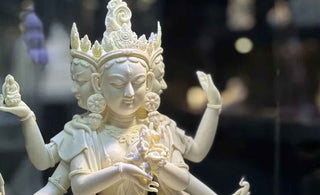
The world of Tibetan antique statues is a testament to the unparalleled craftsmanship that has adorned these sacred artifacts for centuries. The keyword "details" unveils a realm of meticulous artistry, where every curve, every gesture, and every expression is a brushstroke in the canvas of spiritual expression. These statues, aged by time and touched by devotion, beckon us to embark on a journey of appreciation for the fine details that elevate them beyond mere objects into embodiments of divine narratives.
In the dimly lit halls of temples and private collections, Tibetan antique statues silently whisper stories through their details. The art of crafting these masterpieces involves an intricate dance between the artisan's hands and the spiritual vision embedded in each statue. Take, for example, a Tibetan antique Green Tara statue—a celestial embodiment of compassion and protection. The fine details of Tara's multiple arms, each adorned with symbolic attributes, reflect not only the artisan's skill but also the profound spiritual significance attributed to each element.
The faces of these statues, weathered by time and adorned with intricate expressions, are windows to the soul of Tibetan spirituality. The faces of Tibetan antique statues, weathered by the hands of time, emerge as timeless portals to the soul of Tibetan spirituality.
In the case of the 18th Century Yamantaka Tibetan Antique Buddha Statue, cast in Bronze Gilt and originating from a Tibetan Palace, the face becomes a narrative of spiritual profundity. The delicate lines etched into the statue's countenance are not mere weathered marks; they are echoes of centuries, witnesses to the ebb and flow of devotion within the walls of a Tibetan palace. The nuanced expressions, preserved in the subtle curves and contours, reflect a dedication to capturing the essence of Yamantaka—the fierce and compassionate embodiment of the enlightened mind. As the bronze surface bears the patina of ages, it is as if the statue itself has absorbed the prayers and aspirations of generations. The weathering becomes a testament to the enduring nature of Tibetan spirituality, where the passage of time does not diminish but enhances the spiritual resonance of the artifact. Each wrinkle, every fine line, tells a story—a story of worship, resilience, and a connection that transcends the physical form. The Yamantaka statue, with its weathered face, becomes a living chronicle, inviting those who behold it to peer into the depths of Tibetan spirituality and witness the sacred journey that has unfolded over centuries within the hallowed halls of a Tibetan palace.The serene countenance of a Buddha statue, whether in meditative repose or compassionate engagement, is a result of the artisan's dedication to capturing the essence of enlightenment. The delicately carved eyes, imbued with a timeless gaze, seem to transcend the material realm, inviting contemplation on the nature of existence.
The lotus flower, a recurrent motif in Tibetan antique statues, becomes a canvas for artisans to showcase their virtuosity. The petals, meticulously rendered, symbolize purity rising from the murky waters of samsara. Each layer of the lotus unfolds with precision, mirroring the layers of spiritual realization in the Buddhist path. Attention to detail is not merely an aesthetic choice but a spiritual endeavor to convey profound teachings through artistic expression.
Beyond the surface, the details extend to the very core of these statues. Many Tibetan antique statues are crafted using repoussé, a technique where metal is shaped by hammering from the reverse side. This meticulous process results in statues with intricate detailing both inside and out. Consider a Manjushri Bodhisattva statue, where the flowing robes are not just external adornments but conceal a world of detailed carvings within. The unseen details are a testament to the artisan's commitment to perfection, even in areas hidden from the viewer's eye.
The intricate details of Tibetan antique statues also extend to the accessories and ornaments that adorn these divine figures. Crowns, jewelry, and celestial garments are not mere embellishments but integral components of the narrative. They are crafted with precision, reflecting the status and attributes of the deities they represent. A Chenrezig statue, for instance, may be adorned with a crown symbolizing the union of wisdom and compassion, each jewel and ornament intricately placed to convey spiritual symbolism.
The crafting of these statues is a sacred endeavor that goes beyond artistic skill; it is a form of spiritual practice. The artisan, often guided by religious principles, infuses each stroke with devotion, turning the act of creation into a meditative ritual. The very process of creating these statues becomes a form of worship, with the artisan as a conduit for divine expression.
Appreciating the exquisite details in Tibetan antique statues is not merely an aesthetic exercise but a spiritual journey. It is an invitation to delve into the layers of symbolism, to decipher the hidden meanings behind every carved feature, and to connect with the profound teachings encapsulated in these silent sculptures. The details, whether visible or concealed, carry the weight of centuries of spiritual wisdom, inviting us to witness the convergence of art and enlightenment.
Conclusion
In conclusion, the appreciation of exquisite details in Tibetan antique statues is an ode to the masterful craftsmanship that has shaped these timeless artifacts. It is a recognition of the artisans who, across generations, have poured their skill, devotion, and spiritual understanding into every facet of these statues. As we stand before these silent sentinels of Tibetan spirituality, we are not merely spectators but participants in a dialogue that transcends time—an exploration of the divine intricacies that continue to resonate through the ages.

18th Century Yamantaka Tibetan Antique Buddha Statue Bronze Gilt From Tibetan Palace
























